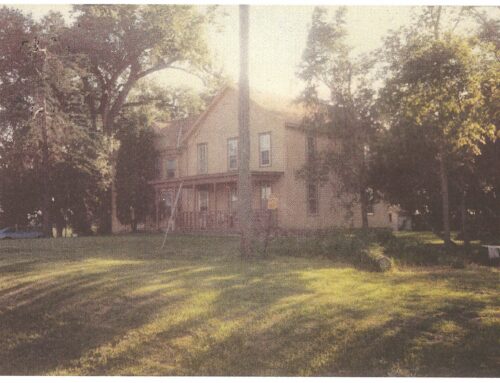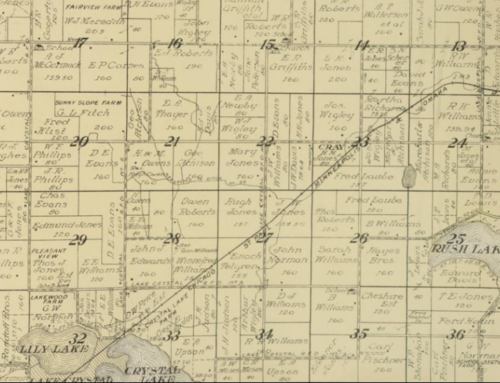 Most of us have heard about the rationing of gas and sugar during World War II. We may know about Victory Gardens or the shortage of farm workers. But did you know that each township in Blue Earth County had Air Raid Wardens and enemy aircraft spotters? Did you know that Blue Earth County practiced blackouts?
Most of us have heard about the rationing of gas and sugar during World War II. We may know about Victory Gardens or the shortage of farm workers. But did you know that each township in Blue Earth County had Air Raid Wardens and enemy aircraft spotters? Did you know that Blue Earth County practiced blackouts?
In July 1940, enemy aircraft spotters were appointed, one for each township. Spotters were chosen for their central location in the township, nearness to a telephone, and ability to speak clearly over the telephone. Control centers were to be set up in towns and most villages. Vernon Center Township was the first to organize all their air raid wardens
It wasn’t until late in 1942 that the area began to practice blackouts. The first occurred in November, with a half-hour blackout, from 10:00 to 10:30. First darkened were homes and businesses, then street lights, followed by motorists pulling over to the curb and turning off lights. All pedestrians were to get off streets and sidewalks. If one happened to be outside or in a car, cigarettes were not to be lit. One casualty was reported during that first test. Delmer Julian, air raid warden on North 2nd street, slipped and broke his leg. A second test on December 14, 1942, blacked out a quarter of the United States for 20 minutes, from Colorado to Minnesota. After this test, four businesses and two homes were fined for not complying. However, the lights were unintentional. A light on a radio had not been sufficiently covered in one home, a fire in the kitchen range was visible in another, and a lighted clock had not been unplugged in a business place.
Ken Berg’s column in The Free Press in 1991 recalled the drills, pointing out that there were no bombers of the period that could have flown this far into the United States. Blackouts helped dramatize the civilian involvement in the war effort, however.
There were other home front efforts during the war that may surprise us today. March 18, 1942, was the last day pants with cuffs were sold in Mankato. The cuffs were to be cut from all suits presently in stores, and cuffed pants would no longer be made, in an effort to conserve wool. Trousers were to be made without pleats, and new suit coats would be designed without vents, belted backs, pleats, or wool patch pockets. Wool cut off the pants already in stores was to be given to the county’s Red Cross unit to be sold to woolen mills.
Summer, 1942 saw a run on hosiery counters in Mankato with the prospect of a shortage of raw silk. Customers were limited to the purchase of only one pair. The shortage of cotton and wool led to the development of a three-cornered disposable paper diaper, first sold in 1943. A distraught father described them as “of smaller size and less absorbent qualities” after three dozen pre-war diapers were stolen from their clothesline on Clark Street.
Milkweed pods became a precious item in 1944, used for filling for life jackets, replacing Kapok. It was estimated that at least two million bags were needed to meet military requirements. In September of that year, Boy Scouts and 4-H Clubs in the county were encouraged to harvest the pods, according to the county agent, L.E. McMillan.
Recycling is nothing new. “When you shop – Bring your own container or shopping bag” read posters published in The Free Press, “Our Soldiers’ Lives Depend on It!” World War II efforts were Patriotic and mandatory for recycling waste paper, rubber, tin cans, and scrap metal. A salvage pledge card encouraged people to “recanvas [their] premises thoroughly for such waste materials as metals, rubber, burlap bags, and rags excepting things we cannot do without.” Flyers helped recyclers to understand the need: one old set of golf clubs would make one .30 caliber machine gun; a kitchen sink made twenty-five 3-inch shells; five bathtubs made a half-ton truck, 61 refrigerators made on a light tank.
Newspapers regularly reported the amounts of recyclables collected. In July 1942, Blue Earth County had collected 178 tons of scrap rubber, but could not best the challenge of Redwood County which had collected 243 tons. In the first four months of 1944, 870,720 pounds of waste paper was shipped out of Mankato. Yet in November, that same year, the Boy Scouts collected twenty-two tons of waste paper in two days in Mankato and North Mankato. Much of it was Christmas wrapping paper and gift boxes. Mankato was the area shipping center for the collection of tin. Cans were to be cleaned and returned to local grocery stores. 2 %of each can was pure tin. Approximately 591 pounds of pure tin was reclaimed each month in Blue Earth County.
Old phonographs became a treasurer in 1943 when a drive began to collect 130 of them from Mankato and North Mankato residents. Spring-wound machines were especially desired, to be sent with troops into areas where electricity was not available. Victory Aides, chaired by A. E. Hesla, Mankato High School band director, were to visit every home in both cities to collect them. The city of Amboy held a special drive to collect phonograph motors, turntables, tone arms, screws, and other parts that were needed for repairs.
Planting a Victory Garden, helping farmers during harvest, practicing blackouts, wearing cuffless pants, or recycling, all were part of the residents of Blue Earth County’s contribution to the war effort, and consider to be a patriotic duty.
By Hilda Parks







Leave A Comment